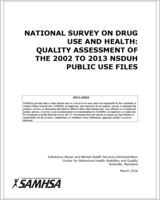All material appearing in this report is in the public domain and may be reproduced or copied without permission from SAMHSA. Citation of the source is appreciated. However, this publication may not be reproduced or distributed for a fee without the specific, written authorization of the Office of Communications, SAMHSA, HHS.
NCBI Bookshelf. A service of the National Library of Medicine, National Institutes of Health.
Structured Abstract
Background:
On an annual basis, the Substance Abuse and Mental Health Services Administration (SAMHSA) collects the National Survey on Drug Use and Health (NSDUH) and subsequently produces NSDUH public use files (PUFs) and restricted-use files (RUFs). The objective of this methodological report is to inform researchers that NSDUH's PUFs maintain high data quality and comparability with NSDUH's restricted-use files (RUFs).
Method:
NSDUH PUF data quality assessment and comparability with the NSDUH RUFs were achieved by performing multiple comparisons of key estimates produced from the two sets of 2002 to 2013 data files based on about 200 tables of substance use and mental health estimates and their respective standard errors.
Results:
Comparisons between the individual 12 years (i.e., 2002 to 2013) of the PUF estimates and RUF estimates indicated that the NSDUH PUFs provide comparable estimates and standard errors for substance use and mental health outcomes and consistent analytic results can be expected between the two types of files even when the actual numbers are different.
Conclusion:
NSDUH's PUFs can be used to obtain reliable estimates for policymakers and to track substance use prevalence or rates of mental health conditions over time.
Contents
- Acknowledgments
- 1. Introduction
- 2. Background and Research Objectives
- 3. Data and Methods
- 4. Quality Assessment
- 5. Discussion
- 6. Conclusions
- References
- Appendix A. Substance Use and Mental Health Tables Selected from the List of NSDUH Detailed Tables and Mental Health Detailed Tables for Comparison, by Year
- Appendix B. Summary of NSDUH Suppression Rules (Applied Only for Restricted-Use File Estimates)
- Appendix C. Comparisons of Selected Substance Use Estimates: 2002 to 2013 NSDUH Restricted-Use Files and Public Use Files
- Appendix D. Comparisons of Selected Mental Health Estimates: 2002 to 2013 NSDUH Restricted-Use Files and Public Use Files
Disclaimer
SAMHSA provides links to other Internet sites as a service to its users and is not responsible for the availability or content of these external sites. SAMHSA, its employees, and contractors do not endorse, warrant, or guarantee the products, services, or information described or offered at these other Internet sites. Any reference to a commercial product, process, or service is not an endorsement or recommendation by SAMHSA, its employees, or contractors. For documents available from this server, the U.S. Government does not warrant or assume any legal liability or responsibility for the accuracy, completeness, or usefulness of any information, apparatus, product, or process disclosed.
This publication may be downloaded from http://www.oas.samhsa.gov. Hard copies may be obtained from http://www.oas.samhsa.gov/copies.cfm. Or please call SAMHSA's Health Information Network at 1-877-SAMHSA-7 (1-877-726-4727) (English and Español).
Suggested Citation
Substance Abuse and Mental Health Services Administration. (2016). National Survey on Drug Use and Health: Quality assessment of the 2002 to 2013 NSDUH public use files. CBHSQ Methodology Report. Center for Behavioral Health Statistics and Quality, Substance Abuse and Mental Health Services Administration, Rockville, MD.
The CBHSQ Methodology Report is prepared by the Center for Behavioral Health Statistics and Quality (CBHSQ), Substance Abuse and Mental Health Services Administration (SAMHSA), an agency within the U.S. Department of Health and Human Services that leads public health efforts to advance the behavioral health of the nation. SAMHSA's mission is to reduce the impact of substance abuse and mental illness on America's communities.
RTI Project No. 0213757.004.107.009.013.
Prepared by RTI International, Research Triangle Park, North Carolina.
RTI International is a registered trademark and a trade name of Research Triangle Institute.

